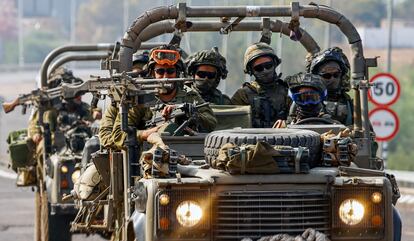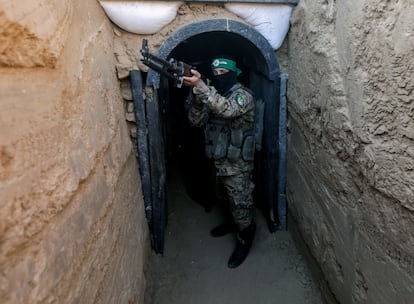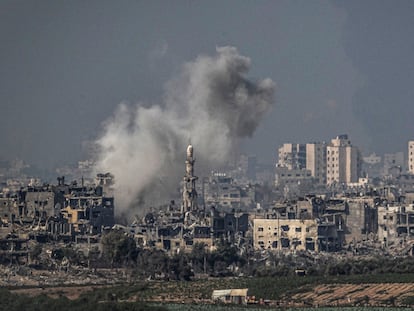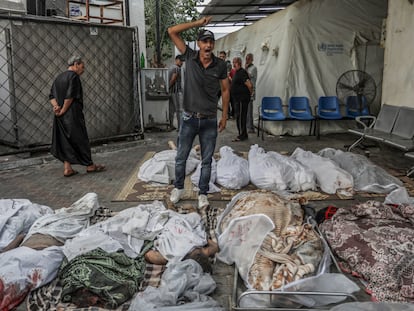Urban warfare in Gaza: Tunnels, hostages, tall buildings and civilian casualties
Israel faces a highly motivated militia equipped with comprehensive knowledge of the battlefield terrain

An Israeli army stands ready while the Hamas urban guerrillas dig in their heels. All that’s missing is the order for the ground invasion to begin. Prime Minister Benjamin Netanyahu says it will happen, but remains tight-lipped about when and how far it will go. With a population density of 5,500 inhabitants per square kilometer, the Gaza Strip is a challenging environment to wage war. Israel wants to eliminate the political and weapons infrastructure of Hamas and then withdraw. However, quickly achieving this objective with minimal loss of life is doubtful, say the experts. Battles like Fallujah and Mosul in Iraq, or more recently, Mariupol and Kramatorsk in Ukraine, are grim reminders of the challenge Israel faces.
Hamas knows it can’t defeat the Israeli army, even with its best weapons — the underground tunnel network and 200 hostages — says John Spencer, a leading urban warfare expert and a U.S. army officer for 25 years. He believes the Israeli invasion of Gaza will last weeks and probably months, leaving behind a destroyed Gaza City and thousands of casualties. The ground assault will require deploying several divisions, each consisting of over 10,000 soldiers, according to analyst Kobi Michael from the Institute for the Study of National Security (INSS), an Israeli think tank. “It will be a very expensive operation, but we have no choice because we’re not going to return to the reality before October 7.”
The Palestinian Red Crescent in Gaza does not have a specific protocol for responding to a military ground invasion, says spokesperson Nebal Farsakh. “As a humanitarian organization, we have emergency plans and scenarios that we update daily. However, the current situation in Gaza surpasses our response capacity. There is no plan for this level of destruction, escalation and blockade. It’s an overwhelming situation that breaks our hearts,” he said.
Two factors differentiate this military operation in the Palestinian enclave: the underground tunnels and the presence of over 200 hostages held by Hamas. Hundreds of the best Hamas fighters died during the surprise attack that killed 1,400 Israelis and sparked the war.
Israel’s military, with 170,000 active members and 300,000 mobilized reservists far surpasses Hamas in sheer power. With advanced technology and strong support from Gazan collaborators, the Israeli Defense Force (IDF) also boasts 2,200 tanks, including the formidable Merkava IV. Since October 7, IDF airstrikes in Gaza the Strip have killed over 7,300 Palestinians. The United States just deployed a team of military advisors specializing in urban warfare, reported the Financial Times.
Hamas has Iran’s backing, modern rockets and combatants willing to fight to the end, says Spencer. “They are willing to make the ultimate sacrifice,” said Kobi Michael from Cyprus, unable to return to Israel due to flight disruptions. The IDF has no choice but to “saturate” Gaza with soldiers, he says.
Spencer estimates that Hamas now has up to 30,000 fighters, compared to 5,000 in previous conflicts. Despite the disparity in military capacity, no one is sure what will happen next. Laying in wait for the enemy on familiar terrain can give the defense an advantage, and keeping hostages as human shields in the tunnels could prevent the Israelis from simply destroying them all.
The tunnel network known as the “metro,” is one of Hamas’s best defenses. It has given them years to prepare for this moment and enables them to employ guerrilla tactics against the enemy. Israeli troops now face the challenge of clearing a dense urban landscape of tunnels, missiles and fighters.
An underground fortress
The underground fortress presents a unique challenge for Israel, as Hamas can evade bombings and aerial intelligence gathering. The militants have had ample time to fortify, stock and booby-trap the tunnels. Yaakov Katz, a defense analyst and former reporter for the Jerusalem Post, warns that Hamas will not hesitate to use civilians as human shields.

“We have to deal with the fact that the Hamas military infrastructure, leaders and weapons are mostly underground,” said Michael, adding that the hostages are probably there as well. “We have to ferret out every last grenade launcher, Kalashnikov and terrorist, so the decisive factor will be getting to its center of gravity.” Anyhow, he warns, “they’ll be ready with traps so we must be cautious and catch them off guard.”
Completely erasing the fundamentalist militia will be very difficult. “Eliminating Hamas is a complex challenge for Israel, and a task that’s even hard to define. But they can take practical steps to weaken Hamas, including neutralizing fighters, degrading its military infrastructure and preventing a repetition of attacks like the one on October 7,” said Katz, acknowledging that as long as a few Hamas members survive, the organization can re-emerge.
“In the Gaza urban battlefield, the key distinguishing element is the third dimension — underground tunnels, tall buildings, and intense drone warfare,” said Michael Knights of The Washington Institute. “Hamas will take the underground war to new extremes,” he said. According to Knights, the 9,000 deaths in the 2017 battle for Mosul against the Islamic State could be easily surpassed in Gaza.
Preparatory raids
John Spencer said Israel will need to bring all its military capabilities to bear, and also “collect intelligence from locals to minimize the risks to hostages.” Qatar is a crucial player in the hostage negotiations, but so far Hamas has only released four women. “We have to assume that not everyone is going to make it out alive,” said Kobi Michael, who is also a professor at the University of South Wales in the UK. Spencer recalled that Israeli soldier Gilad Shalit was held for five years in Gaza until he was exchanged for 1,000 Palestinian prisoners. Hamas is currently demanding the release of 6,000 Palestinians from Israeli prisons in exchange for the 200 hostages it currently holds captive.
Israel has conducted airstrikes and raids into Gaza, including tank-led operations, to assess enemy positions, gather intelligence and neutralize threats. Spencer believes the aerial bombardments will continue even after ground troops enter, and the IDF will also utilize drones, helicopters and low-flying planes for precision attacks.
“There is no safe place in Gaza,” said 23-year-old Abdalla Hasanen from Rafah, the southernmost town in Gaza on the Egyptian border. “I was born here and lived here all my life. I’ve seen a lot of conflict and violence, more than I can remember,” said the young activist with We Are Not Numbers, an organization seeking to put faces to impersonal statistics. “We’re not ready for this type of ethnic cleansing... but even if they push all the way to Rafah, we won’t leave Gaza.”
Sign up for our weekly newsletter to get more English-language news coverage from EL PAÍS USA Edition
Tu suscripción se está usando en otro dispositivo
¿Quieres añadir otro usuario a tu suscripción?
Si continúas leyendo en este dispositivo, no se podrá leer en el otro.
FlechaTu suscripción se está usando en otro dispositivo y solo puedes acceder a EL PAÍS desde un dispositivo a la vez.
Si quieres compartir tu cuenta, cambia tu suscripción a la modalidad Premium, así podrás añadir otro usuario. Cada uno accederá con su propia cuenta de email, lo que os permitirá personalizar vuestra experiencia en EL PAÍS.
¿Tienes una suscripción de empresa? Accede aquí para contratar más cuentas.
En el caso de no saber quién está usando tu cuenta, te recomendamos cambiar tu contraseña aquí.
Si decides continuar compartiendo tu cuenta, este mensaje se mostrará en tu dispositivo y en el de la otra persona que está usando tu cuenta de forma indefinida, afectando a tu experiencia de lectura. Puedes consultar aquí los términos y condiciones de la suscripción digital.
More information
Archived In
Últimas noticias
Chris Martin, Taylor Swift, Elijah Wood and other famous wedding ‘crashers’
‘How does it feel to be a failure?’: Elizabeth Berkley’s journey from ‘Showgirls’ ridicule to vindication
The story of the Málaga virus: The code that haunted Google’s cybersecurity center director for 30 years
The impact of Ecuador’s mega-prison: A polluted river, cleared forests and military checkpoints
Most viewed
- Christian Louboutin: ‘Young people don’t want to be like their parents. And if their parents wear sneakers, they’re going to look for something else’
- The low-cost creative revolution: How technology is making art accessible to everyone
- All the effects of gentrification in one corner of Mexico’s Colonia Roma
- Liset Menéndez de la Prida, neuroscientist: ‘It’s not normal to constantly seek pleasure; it’s important to be bored, to be calm’
- December Social Security and SSI payments: Dates, double checks and the 2026 COLA increase











































